What Temp 2 Cook Slow Beef
Smoking brisket is a BBQ rite of passage, and it can be tricky to cook just right. You take a tough cut of beef and turn it into something tender, flavorful, and moist. Smoking a beef brisket can be a very lengthy process that involves constant temperature tracking. This constant tracking can lead to many trips outside to check on your pit and meat temperatures. That's why we're so excited about our brand new wireless solutions that will make that process easier.
Tracking Temperatures…From Your Smart Device!
Introducing the ThermaQ ® Blue and ThermaQ WiFi 2-Channel Thermocouple Alarms! Designed with serious BBQ pitmasters in mind, both the ThermaQ Blue (available now) and the ThermaQ WiFi (available for pre-order, shipping July 2017) feature Type K thermocouples in both channels with Thermapen® accuracy (±0.7°F/± 0.4°C), and both products broadcast temperatures straight to your smartphone or tablet with our free ThermaQ app (iPhone or Android). Both ThermaQ Blue and ThermaQ WiFi are pictured below with Type K Thermocouple probe kits.
Therma Q Blue ThermaQ WiFi
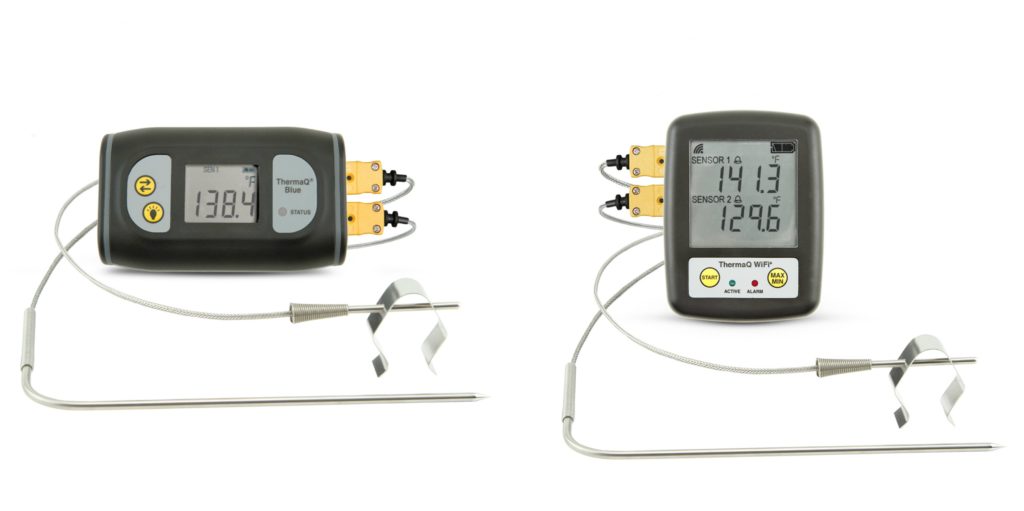
Wireless Temperature Tracking with ThermaQ Blue!
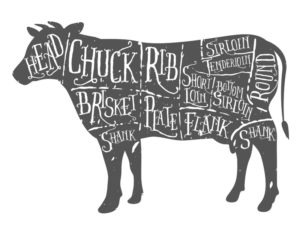 Back to the brisket! Brisket is a cut from the heavily-worked pectoral muscle of the steer. These muscle fibers are tough and are held together with a web of connective tissue. This tissue is primarily made up of collagen. Collagen is a triple-helix protein that needs to be cooked with both the proper temperature and time.
Back to the brisket! Brisket is a cut from the heavily-worked pectoral muscle of the steer. These muscle fibers are tough and are held together with a web of connective tissue. This tissue is primarily made up of collagen. Collagen is a triple-helix protein that needs to be cooked with both the proper temperature and time.
Temperature AND Time
Medium-rare doneness for beef is about 130°F (39°C), but the recommended doneness temperature for brisket is 200-205°F (93°C). Why so high? Because connective tissue doesn't begin to unwind and dissolve until it reaches the temperature range of 160-170°F (71-77°C). The brisket needs to spend hours in the temperature window of 160-205°F (71-96°C) for the best breakdown of connective tissue.
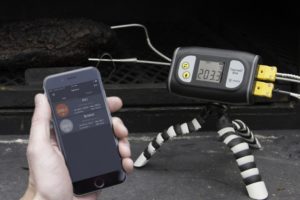 Once this tough collagen has fully dissolved, it turns into gelatin. Gelatin is able to absorb up to ten times its weight in liquid. This means that all of the moisture expelled from protein fibers is able to be reabsorbed by the now rendered gelatin.
Once this tough collagen has fully dissolved, it turns into gelatin. Gelatin is able to absorb up to ten times its weight in liquid. This means that all of the moisture expelled from protein fibers is able to be reabsorbed by the now rendered gelatin.
Smoking Meat Low & Slow
The necessity of breaking down tough connective tissue in cuts of meat like beef brisket and pork shoulder is why we have methods of low and slow cooking. In this case, smoking meat.
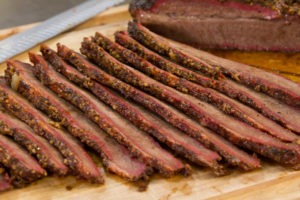 In smoking, meat is cooked slowly in a smoker environment with the temperature range of 225-275°F (107-135°C). This low-temperature range allows ample time for connective tissue breakdown. You could bring a brisket or pork shoulder up to a pull temperature of 203°F (95°C) quickly over the high heat of a grill (500-700°F [260-371°C]), but the connective tissue will not have dissolved. Without the slow, extended cooking time, the meat will still be tough.
In smoking, meat is cooked slowly in a smoker environment with the temperature range of 225-275°F (107-135°C). This low-temperature range allows ample time for connective tissue breakdown. You could bring a brisket or pork shoulder up to a pull temperature of 203°F (95°C) quickly over the high heat of a grill (500-700°F [260-371°C]), but the connective tissue will not have dissolved. Without the slow, extended cooking time, the meat will still be tough.
180 Brisket Recipe
180 is a perfect score for brisket in BBQ competitions. Diva Q was awarded this score using this brisket recipe at a competition in Collingwood, Ontario. The rub, spritz, and wrap in Diva Q's recipe all incorporate umami-rich flavors that make this one of the beefiest tasting briskets you may ever indulge in! Total cooking time is approximately 10-12 hours.
From Diva Q's Barbecue, by Danielle Bennett
Ingredients
- 1 whole beef brisket (14-16 lbs)
- Hickory wood chips
- Oak wood chips
Dry Rub
- 1/4 cup dried granulated onion
- 2 tbsp finely ground porcini mushroom
- 3/4 to 1 cup Montreal steak seasoning
Injection
*We used 2 cups of beef stock with 2 tbsp Worcestershire sauce for our injection
- 2 cups bottled water
- 3/4 cup Butcher BBQ Prime Brisket Injection
Spritz
- 2 cups low-sodium beef stock
- 3/4 cup Worcestershire sauce
- 2 tbsp fish sauce
Wrap
- 1-1/2 cups low-sodium beef stock
- 1 medium white sweet onion, sliced
- 2 tbsp unsalted butter
- 1 tbsp coarsely ground black pepper
- 1 tbsp beef au jus concentrate or concentrated beef bouillon
*In Diva Q's book, this recipe also includes a glaze recipe and instructions for making burnt ends. Yum!
Instructions
Prep the Brisket
- Trim the fat cap on the brisket. Removing the fat will allow for better smoke penetration into the meat. Diva Q recommends trimming so there is no visible fat on the flat. Other experts recommend leaving 1/8″ to 1/4″ of fat on the brisket.

Inject
- Whisk together injection ingredients.

- Inject the brisket at 1-inch intervals, injecting about 1 tbsp each time. Inject until more liquid is coming out than going in.
Apply Rub
- Mix together dry rub ingredients. Apply rub liberally to all sides of the brisket.

- Set aside the brisket for 30 minutes at room temperature before smoking.
Prep Your Smoker
-
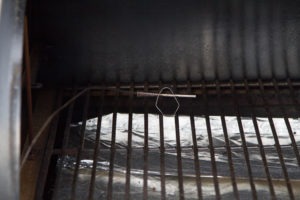 Prepare your smoker or grill for indirect cooking and preheat to 180°F (82°C).
Prepare your smoker or grill for indirect cooking and preheat to 180°F (82°C). - Place your TheraQ Blue's Air Probe securely to the grill grate's surface with its grate clip.
Set Your ThermaQ Blue's Temperatures
Check out the video at the top of this post to see how to use the ThermaQ app.

- Open the app on your smart device. Once your ThermaQ Blue is connected you're ready to go!
- Set the smoker's high alarm to 185°F (85°C) and its low alarm to 175°F (79°C) to maintain your smoker at a temperature of 180°F (82°C).
- You will receive notifications when the alarm temperatures are met so you'll know to add more fuel to your smoker or adjust the vents.
- Set the brisket's high alarm to 203°F (95°C), no need to set a low alarm here.
Start Cooking the Brisket
- Place your ThermaQ's Blue's Smokehouse Penetration Probe into the thickest part of the center of the brisket.
- Add a handful of each type of wood chips to the smoker. Once the chips have started to smoke, lay the brisket on the grate in your smoker.

- Cook for 1 hour.
Spritzing
- Mix together all spritz ingredients and spray the brisket all over with the spritz after it has been in the smoker for 1 hour. Replenish wood chips to maintain smoke.

- Spritzing keeps the exterior of the brisket moist so smoke can penetrate more easily.
- Continue cooking the brisket at 180°F (82°C) for 4 more hours. Spritz the brisket and add a handful of wood chips every hour (use a TimeStick ® to keep track of each hour!).
Smoker Temperature Increase
- After the 4 hours, increase your smoker's temperature to 275°F. Continue cooking for another 2 to 3 hours, until the bark has formed a crust.
- Change your smoker temperature channel's settings in the ThermaQ app. Set the high alarm to 280°F (138°C) and the low alarm to 270°F (132°C).

- While the brisket continues to cook, mix together the wrap ingredients in a saucepan and bring to a simmer. Cool to room temperature.
Wrap the Brisket
- Pull the brisket from the smoker and set it on a double layer of heavy-duty aluminum foil large enough to wrap the entire brisket.
- Shape the foil in a border around the brisket to create a barrier so the wrap doesn't leak out.
- Pour the wrap liquid over the brisket and wrap the brisket tightly in foil, making sure no liquid leaks out.

- Return the brisket to the smoker and continue cooking until the brisket reaches an internal temperature of 203°F (95°C)—2-3 more hours.
- Verify the internal temperature by spot-checking in multiple areas with a Thermapen ® Mk4.

Resting
- Remove the brisket from the smoker and drain off some of the liquid inside the wrap.
- Cover tightly again in the foil, place in a cooler and rest for at least 1 hour.

Because of the low temperatures of smoking, there is usually little to no carryover cooking experienced during the rest.
Slice and Serve
- Remove brisket from the wrap and slice against the grain. Serve with reserved juices. Enjoy!

We love this recipe from Diva Q's new book. The brisket has rich, ultra-beefy flavor. Taking the time to inject, rub, spritz, and wrap during the cook with so many flavorful ingredients is worth it! It's easy to see why this recipe was a competition winner. If a simple, traditional smoked brisket is more your style, see our post, Thermal Tips: Smoked Brisket.
Tracking temperatures like a pro when you're smoking meat just got a little bit easier. Temperature control is critical when smoking a brisket, and the new ThermaQ Blue and ThermaQ WiFi have you covered.
Products Used:
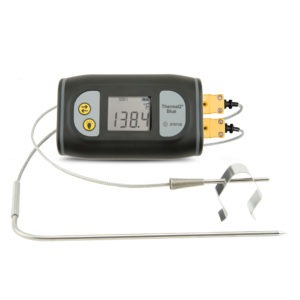 | 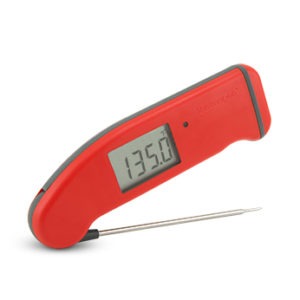 |
|---|
Resources:
Diva Q's Barbecue, Danielle Bennett
Source: https://siemenslowed1977.blogspot.com/2022/06/what-is-safe-temperature-for-beef.html

0 Response to "What Temp 2 Cook Slow Beef"
Post a Comment